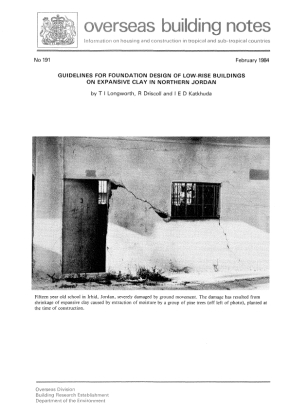Guidelines for foundation design of low-rise buildings on expansive clay in northern Jordan
[edit] About the BRE Trust archive
BRE Trust is a charitable company supporting research and education that advance built environment knowledge, innovation and communication for public benefit. As the owner of the BRE Group of companies the Trust is not only engaged in funding the very latest research, but is also the custodian of nearly a century of built environment research and innovation. This extraordinary legacy provides a unique history of the development of almost every aspect of buildings and construction in the UK.
In 2010 BRE Trust set up a project to make a substantial part of this printed archive available online for the public good. These documents present a fascinating historical record and background to today’s industry, but are not intended to provide guidance on current built environment projects. Much of the information they contain has been superseded by more recent research and standards.
[edit] About this document
'Guidelines for foundation design of low-rise buildings on expansive clay in northern Jordan' was written by T I Longworth, R Driscoll and lED Katkhuda and published by BRE in 1984. It is No.191 in a series of Overseas Buildings Notes providing information on housing and construction in tropical and sub-tropical countries.
[edit] Summary
Many low-rise buildings on expansive clay in the highland area of northern Jordan have been damaged by ground movement. A four-year investigation of the problem has proved that most damage results from vertical ground movements caused by local moisture content changes in the clay. Water infiltration from rainfall and domestic sources causes clay swelling, while moisture loss by evaporation and transpiration causes clay shrinkage. Moisture extraction by trees is the most common cause of damage. This note gives provisional recommendations for safe foundation design, taking account of the findings of the investigation and of present construction practice in Jordan. Types of foundation that isolate the building from the ground movement are considered to be the best design solution. Environmental control measures are suggested to prevent harmful moisture content changes near the foundations.
Featured articles and news
RTPI leader to become new CIOB Chief Executive Officer
Dr Victoria Hills MRTPI, FICE to take over after Caroline Gumble’s departure.
Social and affordable housing, a long term plan for delivery
The “Delivering a Decade of Renewal for Social and Affordable Housing” strategy sets out future path.
A change to adoptive architecture
Effects of global weather warming on architectural detailing, material choice and human interaction.
The proposed publicly owned and backed subsidiary of Homes England, to facilitate new homes.
How big is the problem and what can we do to mitigate the effects?
Overheating guidance and tools for building designers
A number of cool guides to help with the heat.
The UK's Modern Industrial Strategy: A 10 year plan
Previous consultation criticism, current key elements and general support with some persisting reservations.
Building Safety Regulator reforms
New roles, new staff and a new fast track service pave the way for a single construction regulator.
Architectural Technologist CPDs and Communications
CIAT CPD… and how you can do it!
Cooling centres and cool spaces
Managing extreme heat in cities by directing the public to places for heat stress relief and water sources.
Winter gardens: A brief history and warm variations
Extending the season with glass in different forms and terms.
Restoring Great Yarmouth's Winter Gardens
Transforming one of the least sustainable constructions imaginable.
Construction Skills Mission Board launch sector drive
Newly formed government and industry collaboration set strategy for recruiting an additional 100,000 construction workers a year.
New Architects Code comes into effect in September 2025
ARB Architects Code of Conduct and Practice available with ongoing consultation regarding guidance.
Welsh Skills Body (Medr) launches ambitious plan
The new skills body brings together funding and regulation of tertiary education and research for the devolved nation.
Paul Gandy FCIOB announced as next CIOB President
Former Tilbury Douglas CEO takes helm.
UK Infrastructure: A 10 Year Strategy. In brief with reactions
With the National Infrastructure and Service Transformation Authority (NISTA).
























